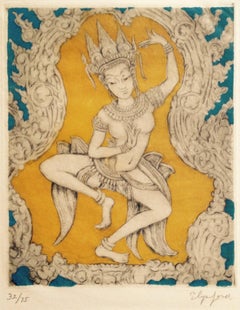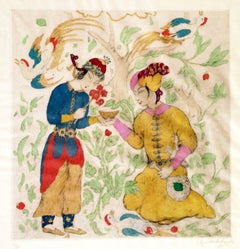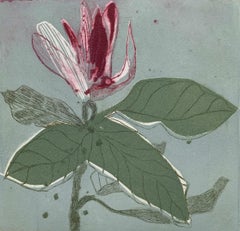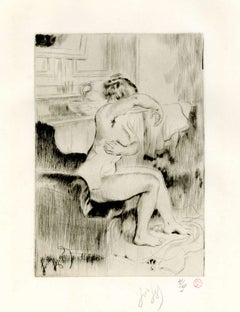Elyse Ashe Lord Figurative Prints
British, 1900-1971
Elyse Ashe Lord, painter, and printmaker, is well-known for her works inspired by the Far East and for her unusual, multi-layered printmaking technique, which involved a combination of etching, drypoint, aquatint ,and woodcut. She lived her entire life in Britain and although her work shows a strong Asian influence, she never actually traveled the continent. Her inspiration instead came from Chinese literature, artwork and her own imagination. Her unique style uses fine drypoint lines and delicate, yet vibrant colors to create images that have a serene, almost dreamlike quality.to
1
Overall Width
to
Overall Height
to
4
859
382
377
308
2
2
1
2
2
2
1
1
1
2
2
2
2
Artist: Elyse Ashe Lord
Celestial Nymph I
By Elyse Ashe Lord
Located in New York, NY
Elyse Ashe Lord (1900-1971), Celestial Nymph I, c. 1930, color etching, soft ground, drypoint; signed lower right in pencil and numbered by the artist lower left. In very good condition, the full sheet, 8 1/4 x 10, the sheet 17 x 13 1/2 inches.
A fine impression, with strong color and plate tone on the nymph and surrounding decorations, and with pencil additions in various places on the nymph by the artist (using the same pencil as with signing). Printed on a light laid ivory Japan paper.
Provenance:
Kennedy Galleries, New York (with their stock number A 32064)
Elyse Ashe Lord developed her unique artistic style exclusively around oriental subject matter. Her art was inspired by both Chinese art and various aspects of oriental culture. Although E.A.Lord never actually travelled to China, she used Chinese paintings, embroideries and wall hangings, together with objects from surrounding Eastern countries, as the sources for her images. The highly individual style which Elyse Lord created reflects both this source material and the influences of Art Deco and early 1920’s fashion.
In particular, Elyse Lord is unusual in combining the technique of drypoint with woodcut colour printing. She uses the drypoint design almost as the Japanese would have used a key block in multiple block colour printing. The colours would then be added by over-printing the drypoint design using colour-inked wood blocks, precisely as displayed by this unique series of progressive proofs. Elyse Lord would always supervise the difficult process of printing her plates and blocks, in person. [I am indebted to Michael Campbell...
Category
1930s Other Art Style Elyse Ashe Lord Figurative Prints
Materials
Drypoint, Etching
Couple Under a Tree
By Elyse Ashe Lord
Located in New York, NY
Elyse Ashe Lord (1900-1971), Couple Under a Tree, c. 1930, color etching, soft ground, drypoint; signed lower right in pencil and numbered by the artist lower left. In very good condition, the full sheet, 11 3/4 x 12 1/4, the sheet 17 x 16 inches.
A fine impression, with strong colors and plate tone. Printed on a light laid ivory Japan...
Category
1930s Art Nouveau Elyse Ashe Lord Figurative Prints
Materials
Drypoint, Etching
Related Items
Magnolia 10 - Contemporary Figurative Drypoint Etching Print, Flower, Floral
By Marta Wakula-Mac
Located in Warsaw, PL
MARTA WAKUŁA-MAC: Master of Arts in Fine Art Education- Diploma in Fine Art Printmaking at the Institute of Art, Pedagogical University, Krakow, 2003. Member of Graphic Studio Dubl...
Category
2010s Contemporary Elyse Ashe Lord Figurative Prints
Materials
Paper, Drypoint, Etching
$170 Sale Price
20% Off
H 5.91 in W 6.11 in
La Toilette
By Louis Legrand
Located in Fairlawn, OH
La Toilette
Drypoint, 1908
Signed and numbered in pencil by the artist (see photos)
Edition: 65 this state (35/65)
Published by Gustave Pellet (1859-1919),...
Category
Early 1900s Art Nouveau Elyse Ashe Lord Figurative Prints
Materials
Drypoint
Nude VIII - XXI Century, Contemporary Figurative Drypoint Etching Print
By Marta Wakula-Mac
Located in Warsaw, PL
MARTA WAKUŁA-MAC: Master of Arts in Fine Art Education- Diploma in Fine Art Printmaking at the Institute of Art, Pedagogical University, Krakow, 2003. Member of Graphic Studio Dubl...
Category
2010s Contemporary Elyse Ashe Lord Figurative Prints
Materials
Paper, Drypoint, Etching
$180 Sale Price
20% Off
H 6.5 in W 3.15 in
Nude XIII - XXI Century, Contemporary Figurative Drypoint Etching Print
By Marta Wakula-Mac
Located in Warsaw, PL
MARTA WAKUŁA-MAC: Master of Arts in Fine Art Education- Diploma in Fine Art Printmaking at the Institute of Art, Pedagogical University, Krakow, 2003. Member of Graphic Studio Dubl...
Category
2010s Contemporary Elyse Ashe Lord Figurative Prints
Materials
Paper, Drypoint, Etching
$180 Sale Price
20% Off
H 6.5 in W 3.15 in
La Loge (The Lodge) /// Post-Impressionist Figurative French Paris People Art
By Louis Legrand
Located in Saint Augustine, FL
Artist: Louis LeGrand (French, 1863-1951)
Title: "La Loge (The Lodge)"
Portfolio: Gazette des Beaux-Arts
*Issued unsigned, though signed by LeGrand in the plate (printed signature) l...
Category
Early 1900s Post-Impressionist Elyse Ashe Lord Figurative Prints
Materials
Drypoint, Etching, Intaglio
Portrait de Fanny Charrin /// Female Women Artist French Impressionist Modern
Located in Saint Augustine, FL
Artist: Nori Malo-Renault (French, 1871-1953)
Title: "Portrait de Fanny Charrin"
Portfolio: Gazette des Beaux-Arts
*Issued unsigned
Year: 1909
Medium: Original Etching and Drypoint o...
Category
Early 1900s French School Elyse Ashe Lord Figurative Prints
Materials
Drypoint, Etching, Intaglio
Ancient Roman Architecture: Original Framed 18th C. Etching by G. Piranesi
By Giovanni Battista Piranesi
Located in Alamo, CA
"Veduta del Sepolcro della Famiglia Plauzia per la Strada Che Conduce da Roma a Tivoli vicino a Ponte Lugano" from "Le Antichità Romane" (Roman Antiquities), one of the most famous works by Piranesi. "Antichita" illustrates the tombs along the Appian Way...
Category
Early 18th Century Old Masters Elyse Ashe Lord Figurative Prints
Materials
Etching, Engraving, Drypoint
$3,100 Sale Price
20% Off
H 24.38 in W 31.75 in D 0.75 in
Salvador Dali - The Beloved Feeds Among the Lilies - Signed Aquatint
By Salvador Dalí
Located in Collonge Bellerive, Geneve, CH
SALVADOR DALI (1904-1989)
THE BELOVED FEEDS AMONG THE LILIES, 1971
Board for the series "The Song of Songs hymns"
Aquatint and dry point on wove paper...
Category
1970s Surrealist Elyse Ashe Lord Figurative Prints
Materials
Drypoint, Aquatint
$3,675
H 22.25 in W 14.97 in D 0.04 in
"Portrait of Madame Georges Menier" By Helleu
By Paul César Helleu
Located in Hinsdale, IL
HELLEU, PAUL CÉSAR
(1859 - 1927)
MADAME GEORGES MENIER
Montesquiou XXI
Drypoint in colors, c. 1900
Signed in pencil, lower right
Printed on wove paper
Full Margins
22 1/4” x 13...
Category
Early 19th Century Art Nouveau Elyse Ashe Lord Figurative Prints
Materials
Drypoint, Etching
Spring Song /// Antique Female Artist Children Child Etching British Art
By Eileen Soper
Located in Saint Augustine, FL
Artist: Eileen Alice Soper (English, 1905-1990)
Title: "Spring Song"
*Signed by Soper in pencil lower right
Year: 1924
Medium: Original Etching on cream laid paper
Limited edition: 178
Printer: Likely printed by Eva Soper, London, UK
Publisher: H C Dickens, London, UK
Reference: "The Catalogue Raisonne of Prints and Etchings of George and Eileen Soper" - Beetles No. 83, page 119, 141, 157
Sheet size: 8.13" x 10.13"
Image size: 6.63" x 9.63"
Condition: Paper trimmed in the margins. A few faint areas of discoloration. It is otherwise a strong impression in very good condition
Notes:
Provenance: private collection - Boulder, CO.
Biography:
Eileen Soper was born in 1905 in the Municipal Borough of Enfield and moved to the house where she was to spend the rest of her life in Harmer Green, Welwyn in the Hertfordshire countryside in 1908. The house she later named "Wildings" was built by her father, the artist George Soper...
Category
1920s Modern Elyse Ashe Lord Figurative Prints
Materials
Laid Paper, Drypoint, Etching, Intaglio
$350
H 8.13 in W 10.13 in
La Promenade
By Edgar Chahine
Located in Fairlawn, OH
La Promenade
Etching, soft-ground, aquatint & drypoint,
Signed in pencil lower left
Published by Edmund Sagot, Paris
Edition of 50 in black only, aside from the edition of 50 in co...
Category
Early 1900s Art Nouveau Elyse Ashe Lord Figurative Prints
Materials
Drypoint, Etching, Aquatint
Salvador Dali - Le Cerf from Le Bestiaire de la Fontaine - Signed Engraving
By Salvador Dalí
Located in Collonge Bellerive, Geneve, CH
SALVADOR DALI
Le Cerf se voyant dans l'eau from Le Bestiaire de la Fontaine
1974
Hand signed by Dali
Edition: /250
The dimensions of the image are 22.8 x 15.7 inches on 31 x 23.2 in...
Category
1970s Surrealist Elyse Ashe Lord Figurative Prints
Materials
Drypoint, Aquatint
$2,964
H 29.93 in W 22.84 in D 0.04 in
Elyse Ashe Lord figurative prints for sale on 1stDibs.
Find a wide variety of authentic Elyse Ashe Lord figurative prints available for sale on 1stDibs. You can also browse by medium to find art by Elyse Ashe Lord in drypoint, engraving, etching and more. Much of the original work by this artist or collective was created during the 20th century and is mostly associated with the modern style. Not every interior allows for large Elyse Ashe Lord figurative prints, so small editions measuring 13 inches across are available. Customers who are interested in this artist might also find the work of William Lee Hankey, Sir Frank Brangwyn, and Chas Laborde. Elyse Ashe Lord figurative prints prices can differ depending upon medium, time period and other attributes. On 1stDibs, the price for these items starts at $475 and tops out at $635, while the average work can sell for $500.



